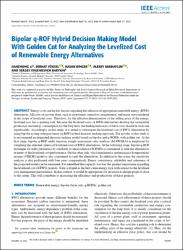Bipolar q-ROF hybrid decision making model with golden cut for analyzing the levelized cost of renewable energy alternatives

Göster/
Erişim
info:eu-repo/semantics/openAccessAttribution 4.0 Internationalhttps://creativecommons.org/licenses/by/4.0/Tarih
2022Üst veri
Tüm öğe kaydını gösterKünye
Li, J., Yüksel, S., Dinçer, H., Mikhaylov, A. ve Barykin, S. E. (2022). Bipolar q-ROF hybrid decision making model with golden cut for analyzing the levelized cost of renewable energy alternatives. IEEE Access, 10, 42507-42517. https://doi.org/10.1109/ACCESS.2022.3168315Özet
Energy costs are the key factors regarding the selection of appropriate renewable energy (RWG) alternatives. All costs of a power plant, such as investment, operation, maintenance, and repair are considered in the scope of levelized costs. Therefore, for the effective determination of the selling price of the energy, levelized cost has a guiding role. Because the levelized costs of RWG alternatives develop the sustainable production and energy consumption for the long term, the leading indicators of these costs should be analyzed significantly. Accordingly, in this study, it is aimed to investigate the levelized cost of RWG alternatives by using bipolar q-rung orthopair fuzzy (q-ROF) hybrid decision-making approach. The novelty of this study is to recommend an integrated decision-making model based on bipolar and q-ROFSs with golden cut. At the first stage, bipolar q-ROF multi stepwise weight assessment ratio analysis (M-SWARA) is employed for weighting the selected criteria of levelized costs of RWG alternatives. At the following stage, bipolar q-ROF technique for order preference by similarity to ideal solution (TOPSIS) is considered to rank the alternatives in terms of the levelized cost performance. On the other side, vise kriterijumska optimizacija i kompromisno resenje (VIKOR) model is also considered to rank the alternatives. In addition to this issue, the sensitivity analysis is also performed with four cases comparatively. Hence, consistency, reliability and coherency of the proposed model can be measured. It is identified that capacity loss has the greatest importance regarding the levelized cost of RWG projects. Solar is found as the best clean energy type with respect to the levelized cost management performance. In this context, it would be appropriate for investors to design projects close to the center. This will contribute to increasing the efficiency and productivity of these projects
WoS Q Kategorisi
Q2Scopus Q Kategorisi
Q1Kaynak
IEEE AccessCilt
10Koleksiyonlar
- Makale Koleksiyonu [202]
- Scopus İndeksli Yayınlar Koleksiyonu [6561]
- WoS İndeksli Yayınlar Koleksiyonu [6621]


















